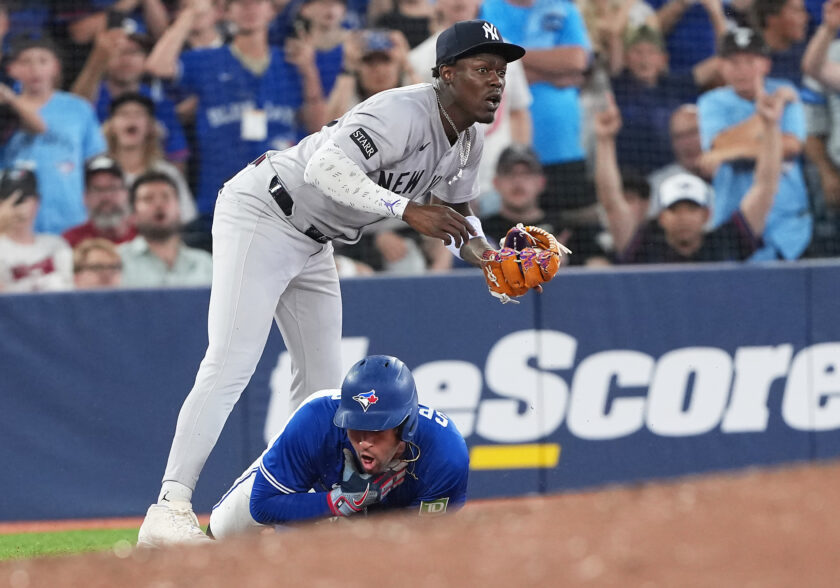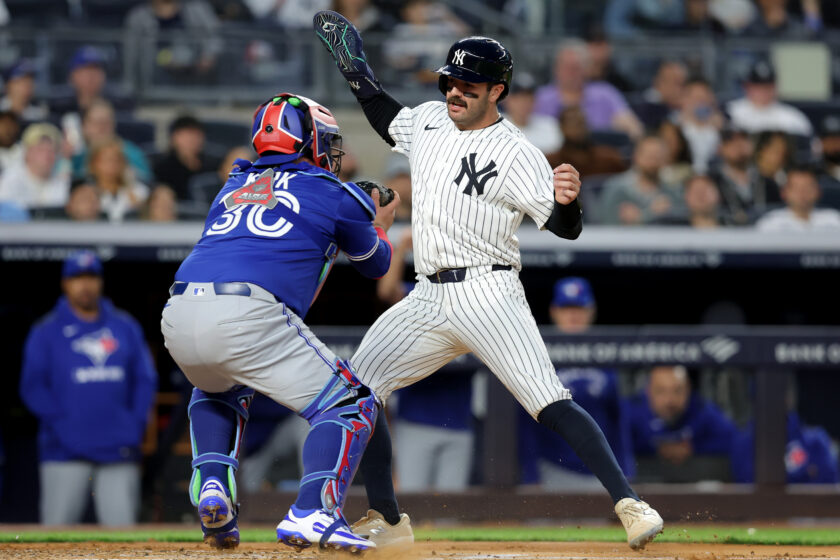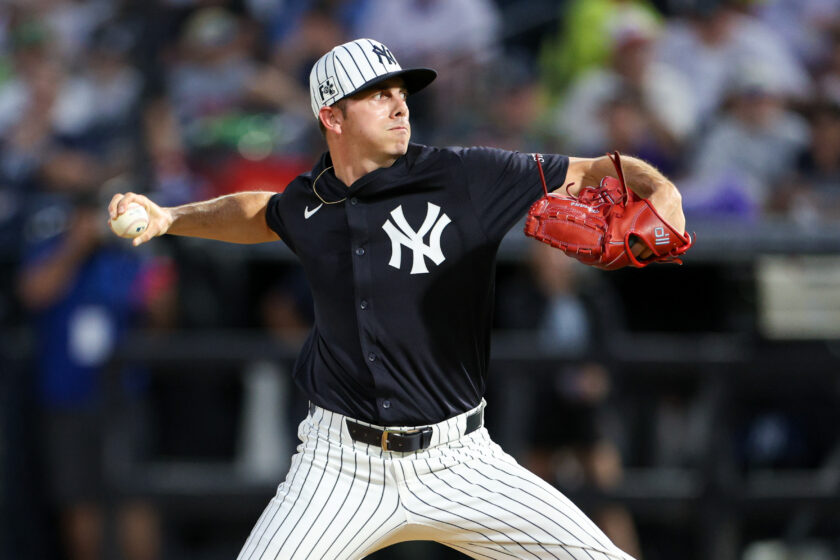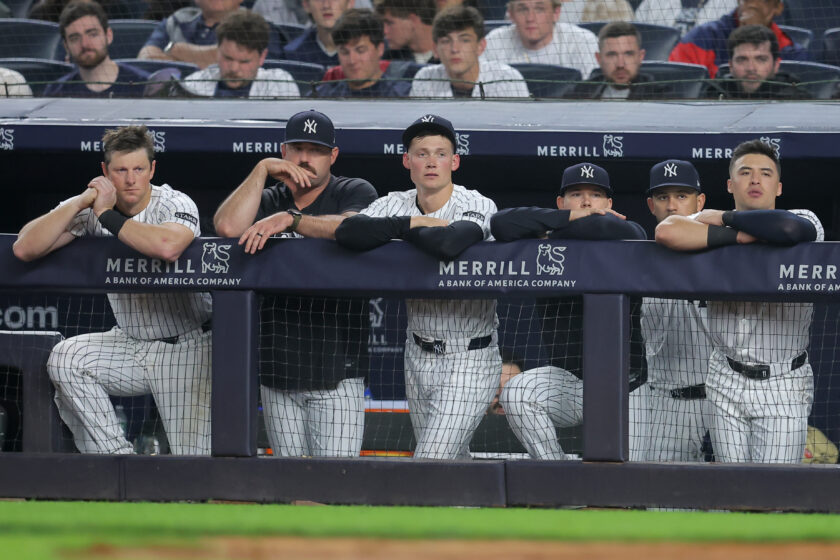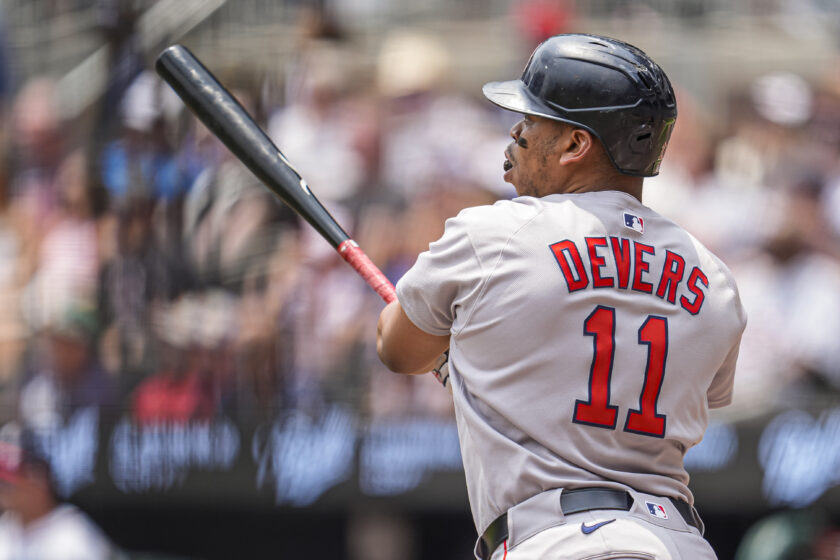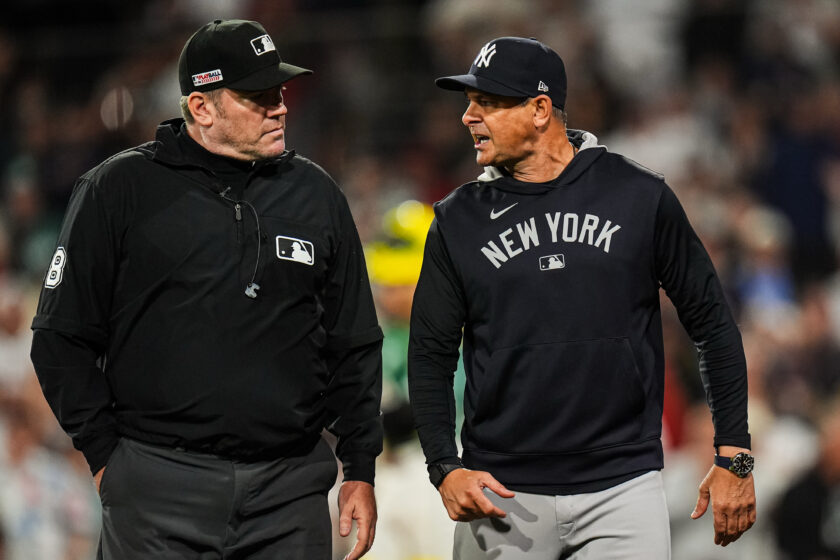New York Yankees: Non-Interference Call Brings Light To Another MLB Flaw

The New York Yankees fell to the Houston Astros on Opening Day yesterday, thanks to an obvious interference call that was not misinterpreted, but is just flat out wrong in the rule book.
By Christian Kouroupakis
 The New York Yankees and the Houston Astros were in a 2-2 stalemate on Opening Day, until an interference call was blow by home plate umpire Dana DeMuth.
The New York Yankees and the Houston Astros were in a 2-2 stalemate on Opening Day, until an interference call was blow by home plate umpire Dana DeMuth.
What if I told you that the call was actually correct and not a miscue by the umpire leading to an Opening Day loss for the Bombers?
I can already feel Yankee fans hastily deleting their “this umpire is blind” tweet from earlier in the day. Let’s take a step back and understand what an umpire’s job is.
These individuals, while they are imperfect, have a task to ensure that the rules of the Major League Baseball are being fulfilled to the best of their ability.
Yesterday, DeMuth was faced with a problematic situation. He had to enforce a rule that was the ultimate cause of a 5-3 loss in the season opener for the Yankees.
Dellin Betances was on the mound, squaring off against the Astros’ young stud Carlos Correa, who hit a slow dribbler up the first base line.
Betances fielded the ground ball cleanly then turned to make a throw to his first baseman, Mark Teixeira, who was stretched out on the inside (left) part of first base in order to receive a throw.
While making his way down the line Correa made his way onto the grass and in the ideal lane that a pitcher uses to feed his first baseman the baseball.
Even if Betances attempted to throw towards the inside part of the bag, he would have nailed Correa with the throw.
With nowhere to throw, the Yankees 6’8″ reliever tried to arc the ball over Correa but ended up tossing the ball into right field allowing Jose Altuve to score.
That gave the Astros a lead they’d never relinquish, and they ended up winning the ballgame 5-3. The turning point was, without a doubt, the “error” by Betances.
RELATED: Yankees Fall Harmlessly To the Astros (Highlights)
Manager Joe Girardi argued the decision because Correa was out of the baseline and on the grass by a solid foot, giving Betances no chance to throw out the reigning American League Rookie of the Year.
The umpiring crew would talk it over, but would eventually stick with their decision that there was no interference by Correa on the play. Girardi was very animated and even protested the contest.
During a protest, the umpire’s interpretation of the rule is what manager’s protest. If they were challenging the fallacy of the rule itself, the Yankees might have won the protest.
To my, and even Girardi’s surprise, he was not ejected from the ballgame. Maybe because the crew agreed that the rule in the book was indeed wrong.
(11) In running the last half of the distance from home base to first base, while the ball is being fielded to first base, he runs outside (to the right of ) the three-foot line, or inside (to the left of ) the foul line, and in the umpire’s judgment in so doing interferes with the fielder taking the throw at first base, in which case the ball is dead; except that he may run outside (to the right of ) the three-foot line or inside (to the left of ) the foul line to avoid a fielder attempting to field a batted ball;
Rule 5.09 (a)(11) Comment (Rule 6.05(k) Comment):
The lines marking the three-foot lane are a part of that lane and a batter-runner is required to have both feet within the three-foot lane or on the lines marking the lane. The batter-runner is permitted to exit the three-foot lane by the means of a step, stride, reach or slide in the immediate vicinity of first base or the sole purpose of touching first base.
The rule book refers to the fielder (in this case Teixeira) and their capability to catch the thrown ball, not the capability of Betances to make an accurate throw. Due to the fact that Betances’ throw was impossible to catch, there is no interference on the play.
Jared Diamond of the Wall Street Journal actually compared it to the pass interference rule in the National Football League. If a quarterback throws a ball 20-feet too high and a defender interferes with the wide-receiver, there is no interference.
Makes sense in the NFL, but in baseball? Not so much. The only possible way Betances was ever going to get Correa out at first, was if he drilled him in the back with his 95+ MPH heater. According to the rule, and DeMuth, that was the only way Correa could have possibly interfered with the baseball.
“Do it. Throw it into the runner’s back,” DeMuth told Diamond. “Because then what’s happening? He is impeding.”
It wasn’t an idiotic call on the field that the umpiring crew got wrong, it’s yet another rule that needs to be addressed in the game of baseball.
Major League Baseball would rather have a fielder assault a base runner with a baseball rather than make it so the base runner has to stay in between the foul line and the three-foot line so the fielder can record an out.
What they don’t realize is, effecting Betances’ capability of making a throw to first is 100% interfering. It’s that simple.
Why do injuries have to be the cause of change in baseball?
It took Buster Posey breaking his leg before the league worked on a new policy in order to prevent that from happening again. It’s not the perfect one, but it prevents career altering injuries.
It took Ruben Tejada breaking his leg on a dirty (but legal in the book) slide by Chase Utley at second base for the league went back an altered the “neighborhood play.”
They aren’t perfect fixes, in fact, both of them take a huge part of the game away, but it prevents career altering injuries which is the ultimate goal in any sport.
Here is baseball’s chance to fix a flawed rule before someone takes a ball to the back of the head. Without a doubt, we’re going to start seeing interfering baserunners get drilled more often because, well, it’s the only way to get an out.
“What’s Dellin’s option there? Hit him in the back? Is that really want we want,” Girardi said via FTW. “They would have called him out if he hit him. That doesn’t make any sense to me because now you’re asking one of our players to assault theirs.”
Solution? Make it so the base runner must, at all times, remain in the three-foot line during their route to first base. In addition, make it so that if they are impeding on the catch and throw (which Correa did) they will be called out.
Take note, Rob Manfred. There is a serious issue in your rulebook that is affecting the outcomes of ballgames, and could eventually affect the health of baserunners who interfere.
NEXT: Castro Rips RBI Double In First Yankee At Bat
Christian Kouroupakis covers the New York Yankees and is the Editorial Director for ESNY. Interact with him and view his daily work by “liking” his facebook page and follow him on Twitter. All statistics are courtesy of Baseball Reference.com unless otherwise noted. Don’t hesitate to shoot him an email with any questions, criticisms, or concerns.

